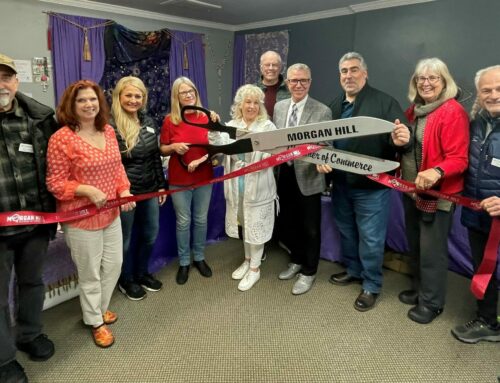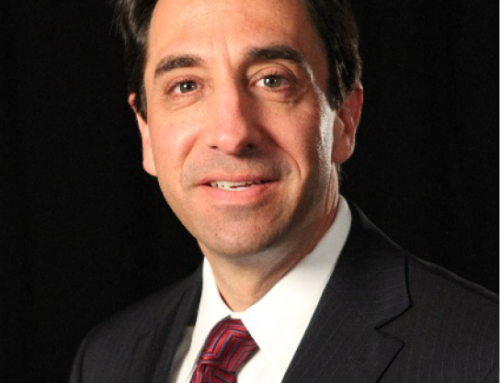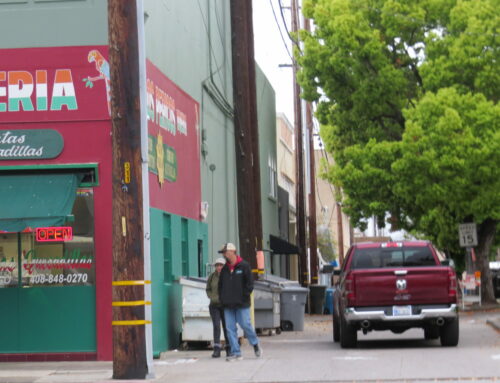Ground-breaking may take place next summer depending on funding
Published in the Oct. 15-28, 2014 issue of Morgan Hill Life
By Marty Cheek

Photo by Marty Cheek
Left: Dennis Kennedy, his dog Nika, and district engineer Stephen Ferranti, on the W. Third Street bridge.
Earlier this year, Santa Clara Valley Water District Director Dennis Kennedy and district staff took Congressman Sam Farr for a tour of the Morgan Hill region. Kennedy explained to Farr that the severe storm waters that occasionally causes Llagas Creek to flood its banks have had a devastating effect on local businesses and homes over the decades. Soon after that tour, Farr asked his chief of staff to put $25 million into the federal Agricultural Appropriations Bill to move the $137-million flood control project forward.
If Congress approves this federal funding, groundbreaking on the 60-year-old Upper Llagas Creek Flood Control Project might take place next summer. Last month, Kennedy traveled to Washington, D.C., and met with representatives and staff of various federal agencies to trigger the federal funding, which would release other funding from the state of California for the project.
“One of the difficult aspects of the project is funding,” Kennedy said. “Years ago, $30 million had been set aside in state subventions. It’s like a fund marked for the project, but it had a condition that it had to have a federal interest in order to utilize those funds. If not for that, the city could have gone ahead sooner. The U.S. Army Corps of Engineers got more restrictive and difficult to give their support to the project. The benefit-to-cost ratio for this project is too low to meet the Corps’s current criteria, so we decided to approach Congressman Sam Farr and go after an agricultural interest in the project through the NRCS and the natural conservation of land.”
The project was originally approved in 1954 by the Natural Resources Conservation Service (at that time called the Soil Conservation Service) to help alleviate the periodic flooding of sections of the 104-square-mile water shed along Llagas Creek, a tributary of the Pajaro River. Once completed, the project will improve flood protection along 13.6 miles of the creek that runs through Morgan Hill, San Martin and Gilroy.
Heavy rains in certain years — mostly recently in 2002, 2008, 2009 and 2011 — brought storm waters that inundated Morgan Hill’s businesses and homes, displacing families and closing roads. Downtown Morgan Hill and the region around Monterey and Watsonville Roads, which are situated along the creek, were particularly hard hit.
The environmental impact and engineering complexity of the project also held back progress. In 1982, an environmental impact study was done, but changes in the law required the water district to initiate another environmental study, which was certified last June. About 140 properties along the creek will be purchased for the project.
The project will also engineer major changes to artificially-created Lake Silveira in the southwestern section of Morgan Hill, bringing it back more to its original wetland state.
“The neighbors are very supportive of turning a portion of that lake into wetlands,” Kennedy said.

Dennis Kennedy, center, with water district staff in front of Capitol Building during September’s visit to Washington, D.C. Photo courtesy Dennis Kennedy
One of the most complex engineering elements of the project is a 12-foot-by-9-foot arched tunnel that will be blasted through the base of Morgan Hill’s Nob Hill a distance of 2,700 feet. This will bypass water around downtown. Originally, the project called for tearing up Monterey Road in downtown Morgan Hill to build a boxed culvert that would pass flood water underground.
The project has reached several funding milestones over the years. In 2009, the water district and the city of Morgan Hill made an agreement where the city would provide $3 million that let the water district take over the Corps environmental contract and hire a design consultant, Kennedy said.
In November 2000, the Clean, Safe Creeks and Natural Flood Protection parcel tax bond measure provided $17 million to the Upper Llagas Creek project for planning and design. In November 2012, Measure B, the Safe, Clean Water bond measure, provided $39.1 million for this project.
After the Great Recession ended, Santa Clara County property tax revenue came in higher than expected, giving the project an additional bump of between $5 to $10 million, Kennedy said.
If Congressman Farr’s proposed $25 million in the Agricultural Bill gets through Congress, the project will receive $30 million in state subventions funding.
“In Washington it is often the squeaky wheel that gets the grease,” Farr said. “It was important that we kept squeaking to make sure the federal government understood why this flood project needed funding. If we can alleviate the flooding problem it will entice more investments in Morgan Hill business to build up our local economy.”

Automobiles moved slowly through flood water that spilled over Llagas Creek in downtown Morgan Hill in a 2011 storm that hit the South Valley region.
Photo courtesy Santa Clara Valley Water District
Businesses and residents of Morgan Hill in the flood zone will feel more secure when the project is finally completed and storm waters no longer surge through the streets and damage buildings and infrastructure, he said.
Congresswoman Zoe Lofgren, who represents Morgan Hill, has also been active in making sure the project kept moving forward over the decades.
“I’ve been working on Llagas Creek for nearly two decades now,” Lofgren said. “The reason it’s so important is because we have seen the unfortunate reality of destruction caused by past flooding in the area. The fact is, until these flood control projects are completed, the area remains vulnerable to severe flooding, which we have seen time and again.”
BookSmart co-owner Brad Jones, a past president of the Morgan Hill Downtown Association, said if Congress approves funding for the flood control project, it will be a “major win” for the community and the downtown. Jones and his wife Cinda Meister had once lived in two homes downtown but decided to move to another area of Morgan Hill because they had grown tired of getting flooded so frequently, he said.
“As far as the progress of downtown goes, it’s a major step,” he said. “I think it’s going to be a major catalyst for getting some of the buildings built downtown that we’ve wanted for many years. I’d just like to see our downtown be relatively flood free in my lifetime.”
The new development in funding the project is key to making flood control a reality in the Morgan Hill region in the next few years, Jones said.
“If the money is there, it won’t take that long at all. It’s always been that the funding has been put in and taken back out,” he said. “You actually have to have the money put in place and actually stick there to get the project done.”







